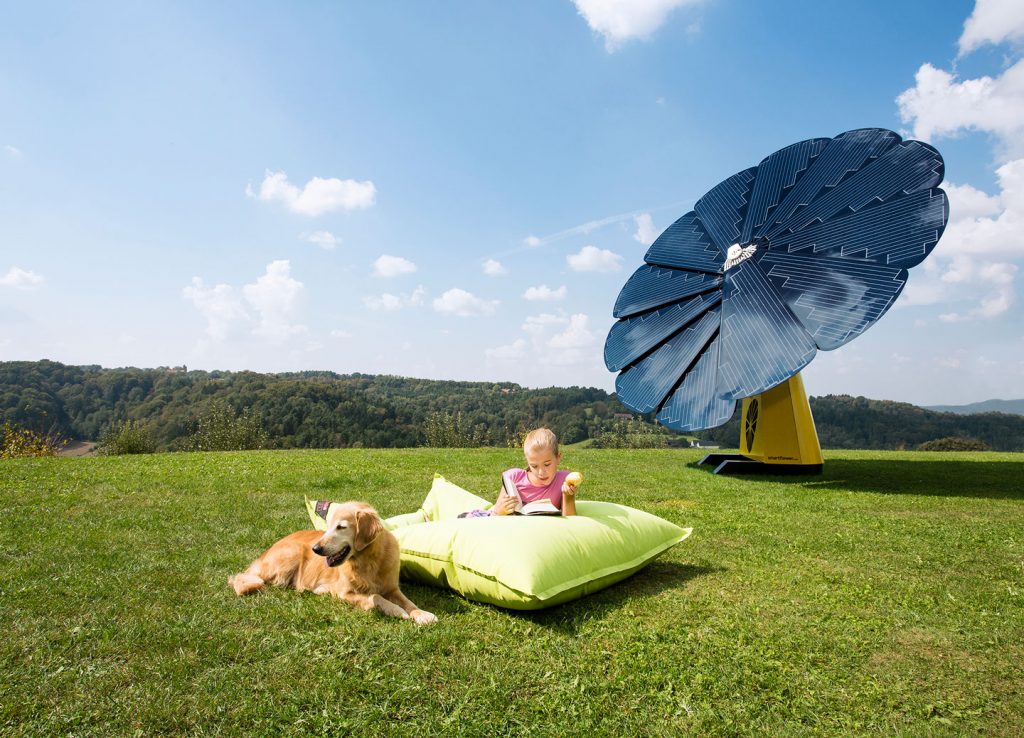You may have seen solar systems on homes or businesses in your neighborhood. Passing through parts of the Southwest, you may have even seen ground-mounted solar farms. But if you were lucky, you may have seen a very unique solar array, known as the “Solar Flower.” or “Smart Flower.”
So, what is the Solar Flower, and how does it work?
The Solar Flower is part sculpture, part solar array. Accordingly, the design combines sculpture and technology, resulting in a product more visually appealing than regular solar arrays. After all, techno-economic efficiency is not the only virtue in this life!
In this article, you’ll learn about what a Solar Flower (or Smart Flower) is, how it works, and some points to consider before purchasing one.
Table of Contents
What Is A Solar Flower?

Source: smartflower.com
The Solar Flower is a free-standing solar sculpture. It looks like a flower —perhaps a daisy or a sunflower (at least that’s what some of us here at Climatebiz think).
The array comprises petal-like solar panels that produce electricity through silicon solar cells integrated into its petals.
The Smartflower’s solar array comprises 12 petals, including monocrystalline PERC solar panels. The petals are controlled by a mechanical system that unfurls or furls the petals much like a Chinese-style old-fashioned fan.
The petals vary in how many solar cells they contain, as the list below outlines:
| Petal Number | Number Of Solar Cells | Total Peak Power (Per Petal) |
|---|---|---|
| Petal 1 | 49 | 225 Watts |
| Petals 2-11 | 44 | 215 Watts |
| Petal 12 | 33 | 155 Watts |
The Smartflower also includes an inverter to convert the DC output of the solar panels to AC electricity. The inverter produces a maximum of around 20A at 240V — it can produce either 50Hz or 60Hz of power, making the Smartflower appropriate for both U.S. and other electrical grids.
Launched by a now-defunct Austrian company, the product was rebirthed by subsidiaries that managed to survive in Austria, the United Kingdom, and the USA.
The company offers three products:
- Smartflower, the original product;
- Smartflow Plus, which includes either a 5.5 kWh or 11.4 kWh battery;
- Smartflower EV, which includes an EV charger.
How Does The Solar Flower Work?

As the sun rises, the Smartflower unfurls its panels. A two-axis tracking system then points the flower toward the Sun, much like a sunflower does.
The Smartflower then tracks the Sun during the remainder of the day, pointing itself directly at the Sun. This tracking increases the energy output of the array compared to if the Smartflower was fixed.
Because the entire face of the Smartflower is constantly facing the Sun, it receives more sunlight during the day. As such, it makes more energy during the day.

Source: green-mole.co.uk
At the end of the day, the petals fold up. When this happens, integrated brushes sweep away any dust or soiling.
Self-Protection
Additionally, the Smartflower will protect itself if the weather turns windy. If its sensors detect strong winds (above 40 mph), the Smartflower will fold up its panels immediately. Consequently, this locks the panels into a safety position, protecting them from wind damage. After the storm passes, the Smartflower will automatically clean and unfold its panels.
Free Standing
The Smartflower is totally free-standing and does not need any supporting structure. The company reports that the Smartflower can be installed “in hours.” The Smartflower secures itself to the ground via fixing points, although the exact details depend on local soil conditions. When tracking, the Smartflower is about 17 feet high. It weighs about 1,600 lbs.
Climate And Ventilation
The Sunflower can operate in various climates, from -40°F to 131°F, and from 0 to 100% humidity.
Finally, a key advantage of the Smartflower is that the panels come with plenty of ventilation; this helps increase the solar cells’ energy output.
How Much Energy Does The Solar Flower Produce?
Similar to a conventional solar array, the energy produced by the Solar Flower depends on the region and specifics of the installation.
Nevertheless, the Smartflower produces more energy than a similarly-sized rooftop solar system — 40% more, according to Smartflower’s website.

Source: smartflower.com
Since the Smartflower tracks the Sun, it produces more energy than a standard solar array. For this reason, you can’t use traditional methods, like peak sun hours, to calculate the energy output of the array.
The Smartflower company states that depending on location, the Smartflower can produce between 3,800 kWh and 6,200 kWh of energy per year.
For the most accurate forecast, it’s best to approach the Smartflower company directly to arrange a bespoke energy output calculation.
The product datasheet reports that the Smartflower uses about 400 kWh of energy per year to operate.
However, if you’re really set on producing a DIY estimate of how much energy the Smartflower will produce, you can use NREL’s online solar calculator, PVWatts.
In the following section, you’ll learn how to use NREL’s calculator to produce your own estimates of how much energy the Smartflower might produce if installed at your home or business.
First Example: Phoenix, Arizona
Let’s look at the installation of a Smartflower in Phoenix, Arizona.

Source: nrel.gov
The first value you must put into the calculator is the location. In this example, we’ll use Phoenix, Arizona.
The following values you’ll need to inputs into NREL’s calculator are rather technical. They include:
- DC System Size (kW): 2.5
- Module Type: Premium
- Array Type: 2-Axis Tracking
- DC-AC ratio: 1.10 (located under advanced settings)
Once you input those values, you can click through to the results. PVWatts will show you an annual and monthly breakdown of the system’s energy output.
For the example we’ve examined, the estimated annual output is 6,290 kWh.
Second Example: Dayton, Ohio
For our second example, we’ll look at the installation of a Smartflower in Dayton, Ohio. The technical inputs are the same as those listed above since the Smartflower is the same.
Using NREL’s PVWatts tool, the estimated annual output for a Smartflower at Dayton, Ohio, is 4,688 kWh.
Third Example: Anchorage, Alaska.
Finally, we’ll look at the output of a Smartflower in Anchorage, Alaska. The technical inputs are the same as those listed above since the Smartflower is the same.
Using NREL’s PVWatts tool, the estimated annual output for a Smartflower at Anchorage, Alaska, is 3,700 kWh.
What Power Rating Is The Solar Flower?
The Smartflower has a peak power output of 2.5 kW; for more information on this, you can refer to this article.
The Smartflower connects to a home’s electrical distribution board via a single AC cable.
How Much Does The Solar Flower Cost?
Pricing is not publicly available on the website of the US subsidiary of Smartflower. In addition, supply chain issues, inflation, and other pressures may mean that publicly available pricing is outdated.
However, a review of publicly available prices:
- Smartflower: $30,000
- Smartflower Plus: $45,000
Note that these prices are before any tax credits or incentives have been considered. UK pricing for the Smartflower is available on the UK website.
Pricing for the Smartflower EV is not publicly available but should be available from your local supplier.
How Much Land Does A Solar Flower Use?
One Smartflower takes up about 16 square feet of space. Additionally, some extra land is needed to lay a cable connecting the Smartflower to the building’s electrical board.
Final Thoughts
The Smartflower, or Solar Flower, is an innovative and attractive sculpture that produces solar energy. It’s available in the USA and Europe, offering a balance between aesthetics and practicality.
If you value price and simplicity above anything else, the Smartflower may not be for you. You might be better served by installing a conventional solar array at your home or business, such as a rooftop array. The system will be predictable and trouble-free.
However, if you value a solar installation that is visually striking, and want to make a “splash” at your home, business, or other location, the Smartflower may be right up your alley. The system includes long-term warranties for various components and appears to have been refined as a product since its initial launch. Since it comprises two mechanical drives, it will require more maintenance than a conventional rooftop array.
Using the NREL PVWatts tool and a simple financial calculator, you should be able to determine if the installation makes sense financially. Additionally, photo montages may help you decide if the Smartflower visually suits your home or business.
In conclusion, you should speak directly to your local Smartflower supplier to assess any potential installation for suitability for your needs.

